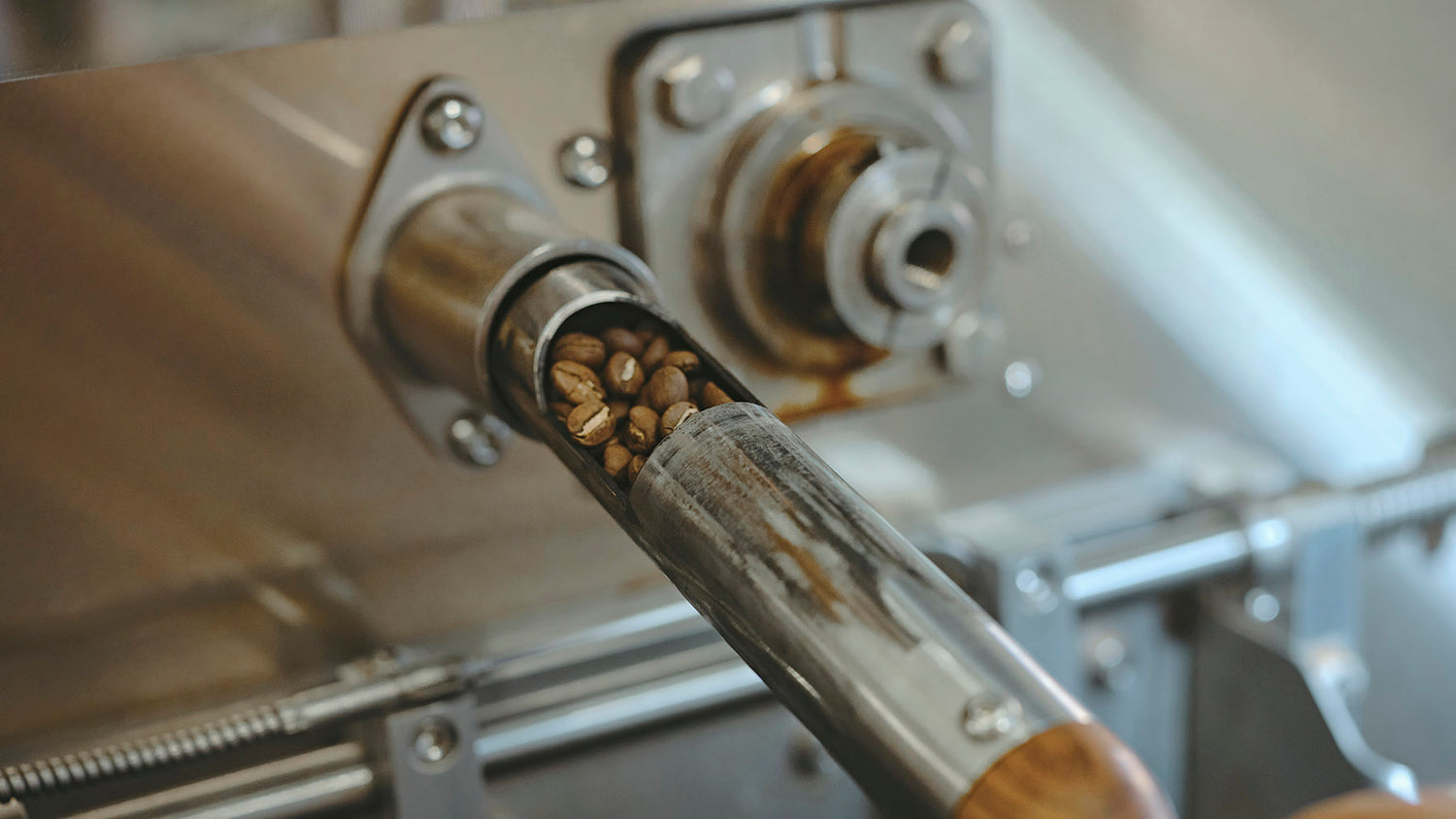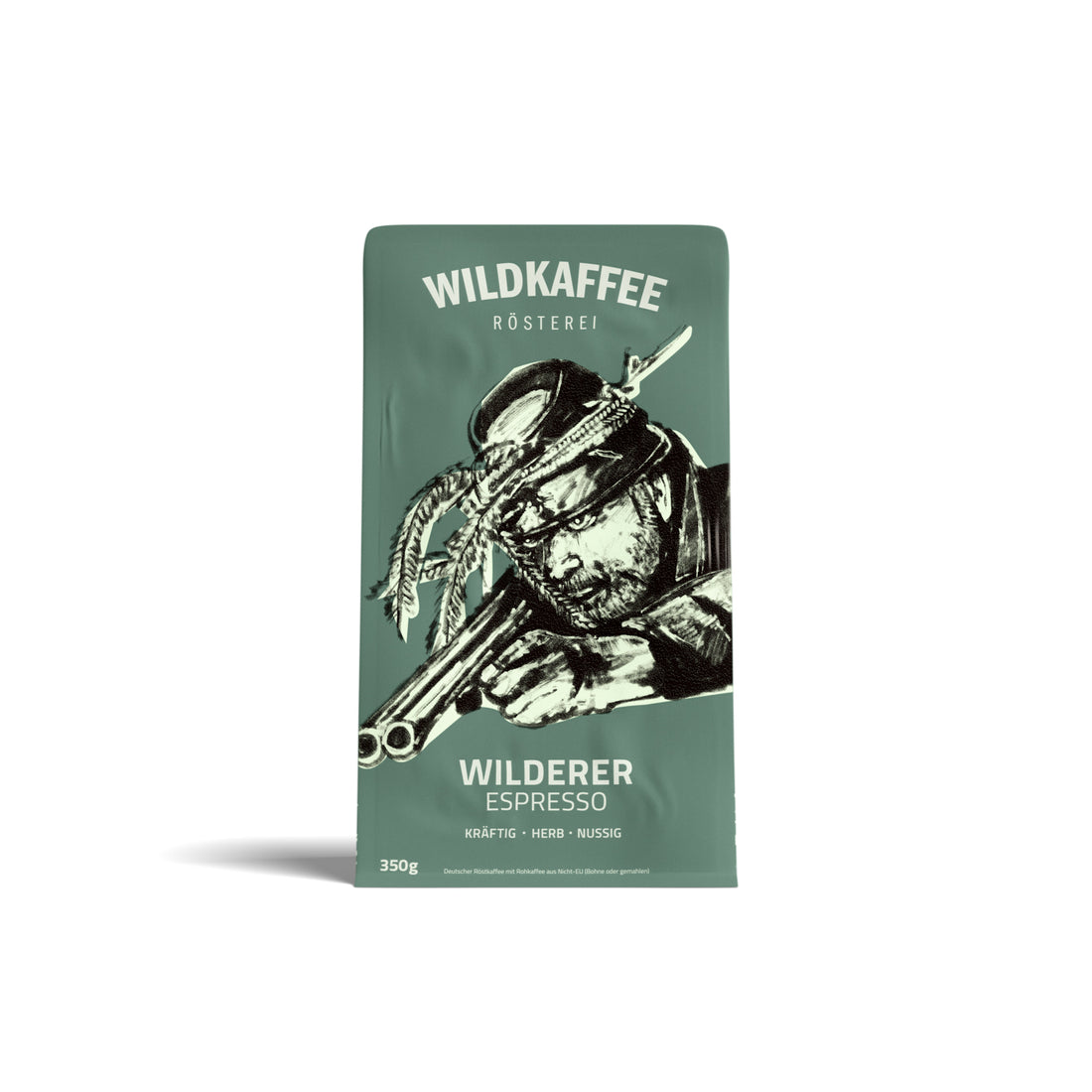What happens when coffee is roasted?
We roast slowly, gently and by hand using traditional drum roasters. This gives the green coffee beans enough time to unfold and develop their own character. In addition to the many years of experience of our roasting masters, we also use modern technology in our roasting process: the Cropster software creates a roasting history based on data measured at various points on the roaster and displays this data on a screen for easy reference. The samples required for this data measure things like the starting temperature in the roasting drum when the beans are added to the roaster, the temperature of the beans themselves, the speed at which the beans absorb heat and the temperature of the exhaust air. Using this data, the roasting master can keep each roast of a specific bean very consistent – so the coffee always tastes good.
From green to brown: the chemical transformation
Roasting is a highly complex thermal process that transforms inconspicuous green coffee beans into aromatic, complex delights. Green coffee contains more than 1,000 components—many of which are tasteless or even unpleasant. The high temperatures (between 160°C and over 220°C) trigger numerous chemical reactions during roasting:
- Maillard reaction: This reaction between sugar and amino acids begins at around 140 °C and creates the brown color as well as a variety of new flavors – from nutty to caramel to bread-like.
- Caramelization: Simple sugars begin to caramelize at around 170°C, producing sweet, roasted notes.
- Pyrolysis: From approximately 200 °C, complex roasted substances are released through thermal decomposition, including bitter substances, roasted aromas and essential oils.
- CO₂ release: The bean produces CO₂ during roasting, which is important later for degassing—especially for espresso. (Because the darker the roast, the more CO₂ in the beans.)
In addition, the physical structure of the

coffee bean
- The bean loses about 12 to 18% of its weight through water and gas loss
- It expands by about 50 to 60% in volume
- The color changes from green to yellowish to medium and finally dark brown
Depending on the roasting profile, you can specifically influence flavor characteristics such as fruitiness, body, or bitterness by controlling the temperature and roasting time. The exact time at which the roasting is stopped determines whether the coffee will later be a light filter roast or a dark espresso roast.
Particularly exciting for professionals: Roasting masters pay attention to the so-called roasting curve – a graphical progression of temperature over time – and use specific turning points, development times and phase lengths to exploit the full potential of the bean.
How is a bean's flavor profile developed? The longer a bean is roasted, the more acidity it loses, while roasted aromas increase. Light roasts retain fruity, floral notes, while dark roasts develop chocolatey, caramel tones with more body.
The most important phases of roasting
1. Drying phase (up to approx. 160°C)
- Escape of moisture (approx. 10 to 12% of the bean)
- Preparation for the chemical reactions
2. Maillard reaction (160 to 180°C)
- Sugar + amino acids = hundreds of flavorings
- The bean begins to turn brown
3. First crack (approx. 196°C)
- The bean cracks open, expansion due to CO₂
- Many light filter roasts end here
4. Roasting depth: Medium to dark roast (200 to 225°C)
- Intensification of roasted aromas
- Formation of bitter substances during over-roasting
5. Second Crack (from approx. 224°C)
- Cell structure continues to break down
- Dark espresso roasts end here at the latest
Differences between light, medium and dark roast
Light coffee roasts - Specialty Coffee
In a light roast, the coffee is roasted for a shorter time and at a lower temperature (approximately 196 degrees Celsius). This results in a light brown color. The shorter roasting time and lower temperature preserve the fruit acids in the beans. The flavor emphasizes the complex acidity, which is particularly popular in specialty coffees.
Medium coffee roasts - Coffee
Medium roasts are roasted a little longer and at a slightly higher temperature (around 215 degrees Celsius). This develops a balanced relationship between body and noticeable acids, which bring a pleasant fruitiness to the cup profile. However, roasted aromas as well as chocolate and nutty nuances are also present.
Dark coffee roasts - Espresso
In dark roasts, the beans are roasted longer and at a higher temperature (around 235 degrees Celsius). This results in a coffee with minimal acidity and intense roasted aromas that evoke a chocolatey, nutty flavor.

What degrees of roasting are there?
The roast levels of light, medium, and dark can be further differentiated and finely graded. This creates many different roast levels, each with its own name.
- Cinnamon Roast: close to first crack, around 196 degrees, light brown color with pronounced acidity
- New England Roast: First crack reaches approximately 205 degrees, complex acidity, moderate light brown
- American Roast: roasted at 210 degrees, medium brown, slightly sweeter, full-bodied with acidic notes
- City Roast: a balanced body with noticeable acidity, at a good 219 degrees a medium brown tone is achieved
- Full City Roast: 225 degrees, medium dark brown, roasted aromas, second crack is noticeable
- Vienna Roast: intense dark brown is achieved at around 230 degrees, bittersweet, caramel notes
- French Roast: 240 degrees, dark brown beans glistening with oil, pronounced roasted aromas, sweet, chocolatey
- Italian Roast: intense dark brown, roasted at 245 degrees, very shiny beans, pronounced roasted aromas, hardly any acidity
What roasting processes are there?
Aside from the traditional method of roasting coffee, where beans are roasted in a pan over a fire, today's main methods are artisanal and industrial. We've documented the home roasting experiment in a blog post here - for anyone who wants to try it.
Drum roasting (artisanal)
- Slow roasting (10 to 20 minutes) at 180 to 220°C
- Intense aroma development
- Gentle on the bean
- Classic at third wave roasters
Hot air roasting (industrial)
- Short roasting time (90 seconds to 3 minutes)
- Temperatures of 400 °C and more
- Often uneven roasting, risk of bitterness
- Cheaper, suitable for the mass market




